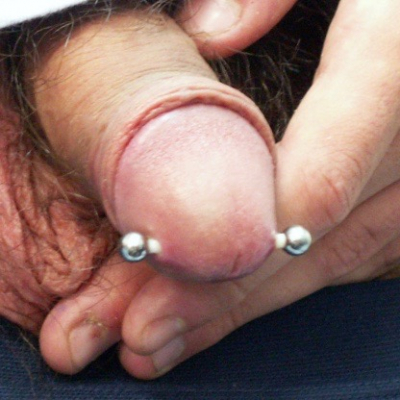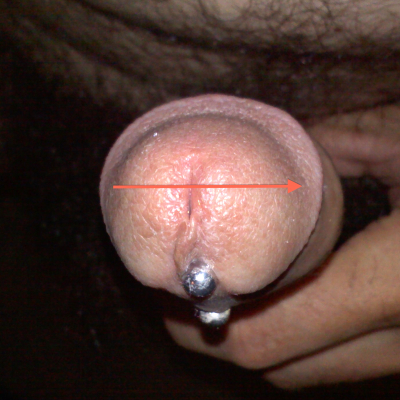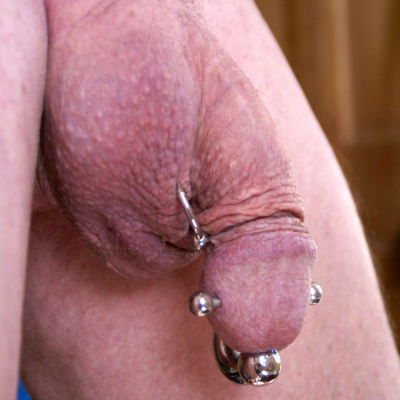
The name ampallang (pronounced “am puh lang”), for the horizontal piercing through the glans, is said to derive from the Dyaks in Borneo. Traditionally, when Dyak boys reached manhood, their rite of passage would be celebrated with the placement of the palang (cross bar) horizontally through the head of the penis; no woman of quality would marry a man without it. Ampallangs are now more popular in modern culture than they are among tribal peoples; today the men in Borneo seldom get them.
General Information
The ampallang is quite similar in many ways to the apadravya piercing, which also passes through the glans.
A bar worn horizontally through the head of the penis can increase sensation and pleasure for both partners. Depending on the angle of penetration, it may be capable of stimulating a woman’s G-spot (a sexually sensitive spot on the front wall of the vagina). Sexual motivations are the inspiration for most men who wear these piercings.
An "iron cross" or "magic cross" is made when the same piercee wears both horizontal and vertical piercings here.
Want to get pierced by Elayne Angel?
Placement
The ampallang piercing passes horizontally through the glans of the penis. What I refer to as the "American ampallang" goes above the urethra, and it is generally set back just in front of the flare of the corona. Commonly it is positioned at about the same level as the upper edge of the urethral opening.
The "European ampallang" is placed considerably lower and more forward on the penis head, and it passes through the urethra. Since the urethra runs along the bottom of the penis, this ampallang really needs to be positioned quite low in order to traverse it. The European version will probably heal faster because it is located where the penis is narrower, so it pierces less tissue; and, because it traverses the urethra, urine may help promote healing. This will not interfere with urination unless the gauge is excessively large.
In general, the question of whether American or European placement is "best" is a matter of personal opinion. For intact men (uncircumcised) the European placement is preferable as the jewelry is less likely to interfere with the natural positioning of the foreskin over the glans.
Note that due to asymmetrical anatomy, it may be necessary to decide whether to situate the piercing perpendicular to the shaft or equidistant on each side from a feature such as the coronal ridge or urethral opening. Or whether to have the piercing appear straight across the top when seen in the bird's-eye view by the wearer vs. level when viewed from the front.
Note that I ALWAYS wear gloves for client contact! Images without gloves were sent to me for consultations, and are posted anonymously and with permission.






Jewelry
The 12 gauge is a reasonably serviceable minimum size for an ampallang piercing. Jewelry over an inch long (and sometimes 1 1/2" or more) is frequently required. The barbell must comfortably accommodate your maximum girth across the glans when you are fully erect.
The jewelry diameter is anatomically dependent, and the post must accommodate your maximum erect measurement. Extra length beyond that is not necessary as this piercing is more apt to bleed than to swell. And there's a certain amount of built-in space since the jewelry is sized to fit you at your largest.
If you book an appointment to get this pierced by me, I require an online (photo) consultation in which I'll mark prospective placement on your pictures and have you measure yourself at that location for post length. Accuracy is crucial because if your bar is too short, it will pinch painfully when you are erect; if it is overly long, it will snag and cause excess trauma. Therefore, precision is important when taking the measurement.
Once fully healed, if you wish to wear a barbell that pinches slightly when you're erect, that might be pleasurable. The fit between intimate partners is unique; some couples enjoy large balls, while others prefer minimal jewelry such as flat discs or small balls. Because the channel is so long, an insertion taper should always be used to help with jewelry changes for this piercing.
Patience is needed to stretch piercings that have a long channel or dense tissue, and the ampallang has both. Another challenge with piercings that have a long channel is that an average insertion taper is about 2 1/2" long, so the entrance side of the piercing may be stretched to the desired gauge before the far side has even been tapered up in size at all. To keep advancing the taper through, maintain constant pressure on it and support the tissue around the exit side. You can have a professional piercer help you with a stretch in the studio, or you can purchase a taper and do it over a more prolonged session at home.

Procedure
Most men find the ampallang rather daunting because of the lengthy piercing channel, though plenty of my clients have said that nipple (and other various) piercings were more sensitive. The ampallang goes through the spongy tissue of the glans, where most nerve endings are capable of conveying the sensation of pressure. You will feel the greatest intensity as the needle exits, where the nerve endings inform you, “This stings!” Even so, piercees routinely say that it wasn’t as bad as they thought it would be.
Because the area is large enough to support well in my fingers, I favor a freehand technique for most ampallang and apadravya piercing. A skilled piercer can accomplish the piercing in just a few moments. The larger the initial gauge, the harder it can be to push through the dense tissue. The 10 gauge can be difficult and take longer to complete.
Learn which piercing(s) you are built for?
Healing and Troubleshooting
Some ampallang piercings do not bleed at all, though many bleed freely but intermittently for several days. I always apply the amusingly named “rubber chicken” wrapping for ampallangs to help you avoid an embarrassing mess. This dressing consists of sterile gauze around the piercing for absorbency, covered by a medical glove (the drooping fingers look like a chicken comb). I secure it with a rubber band that is snug enough to keep the bandage in place, but not so tight as to diminish your circulation. Ampallang piercings regularly bleed enough to fill a whole glove multiple times. Keep the rubber chicken on until it is full and needs to be changed, or until you must urinate. To avoid hard-to-explain messes, reapply a leak-proof wrapping for a day or two longer than you think you need to, even if it seems that your bleeding has stopped.
If your initial jewelry is uncomfortable because it is shorter or longer than you need, have a professional piercer swap it out as soon as possible using an insertion taper to minimize irritation and trauma. It is generally more damaging to leave an ill-fitting barbell in place than to change it early.
You may find that the correct post length catches and causes soreness if you have a large size differential between your flaccid and erect states. A telescoping bar that widens and shrinks with your changing anatomy would be perfect but has yet to be produced. You can loosely wrap the head and jewelry in a figure-eight bandage with roll gauze to support and stabilize the exposed portion of the post and prevent excess jewelry movement.
It does take some time and patience to heal an ampallang piercing. Twice-daily saline soaks are advised in addition to regular care.
What My Happy Clients Say
I told Elayne I wanted an ampallang she was very enthusiastic, very professional and open.
The actual piercing was not painful. It went very quickly, I was amazed at how fast she pierced me and put the barbell through.
The ampallang is perfect and it feels amazing. Elayne did a great job. Guys, it is not as bad as you would think. Especially if you get pierced by Elayne.
Elayne told me to breathe while she got a good hold of me then one final deep slow breath in and then...done! Really I had hardly begun to exhale when it was over! It stung for about a millisecond.
I highly recommend reaching out to Elayne if you are considering a body mod below the neck.
What a great experience.
